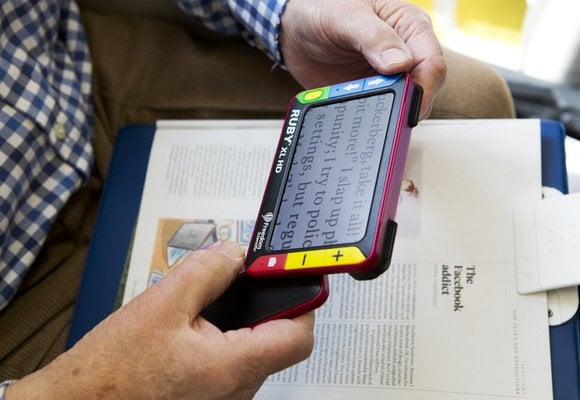Braille displays and notetakers are available to apply for through the RNIB Technology Grant Scheme. Other items include video magnifiers, RNIB PenFriend 3, kitchen equipment, clocks and watches, phones and DAISY players. Click here for more information about grants.
Braille displays and readers
An RNIB guide to braille displays, how they work, and how they are used by blind and partially sighted people.
A braille display or braille notetaker is typically a box with a line of braille cells.
Pins in each of the braille cells move up and down to allow users to read a line of braille text. They range in size from 12 cell lines to 80 cell lines. This can be a computer braille display, smartphone or tablet used to read documents, web pages or social media. They can also be stand alone, so users can access text stored on an SD card.
When used with a computer, braille displays typically require a screen reader to send and control the output from the screen to the braille display. Some displays can also be used to input characters into the computer or to take notes to send to a computer at a later time.
Modern braille displays and notetakers are light and portable with long lasting batteries for convenience, so a user can take them away on holiday or on a journey.
Most braille displays connect via USB cable or wirelessly by Bluetooth. On the device you set up the braille display and from then on both devices will communicate when turned on. Some braille displays can connect to more than one device and you can easily switch devices.
A braille display or notetaker is a great way to read and write documents and text. Speech and braille can complement each other. With a braille display you can easily check spelling, syntax and formatting.
You can learn more about how one of these devices work below.
Everyone has the right to read, and a braille display can give access to books, documents, web sites, etc. You can download books to your smart phone or tablet, then translate them into braille to read in your preferred format on a braille display. You can read the same book as your friends at the same time. A braille display is also good in a working environment where you might be passing on information to colleagues or customers.
Braille displays range in price from £499 to £9,000. We recommended that a hands-on demonstration is requested and undertaken before a purchase is made, to make sure the device is completely suitable. A range of braille devices are available at the RNIB shop.







